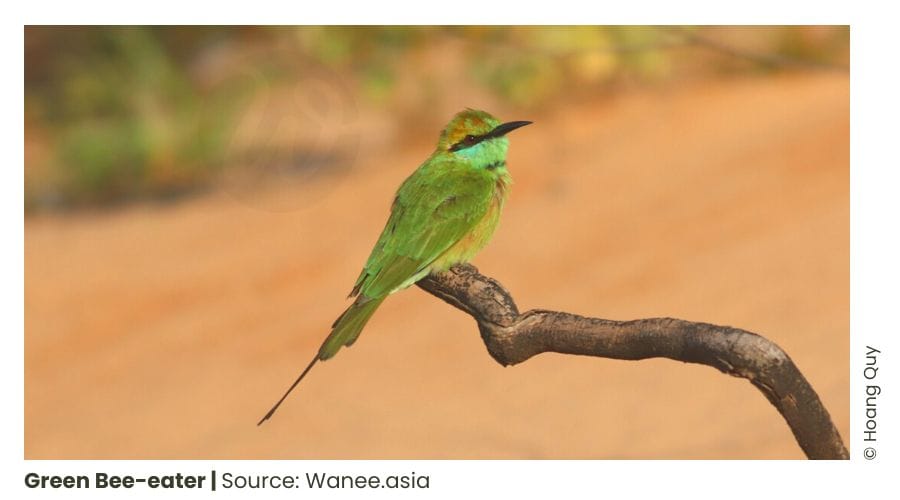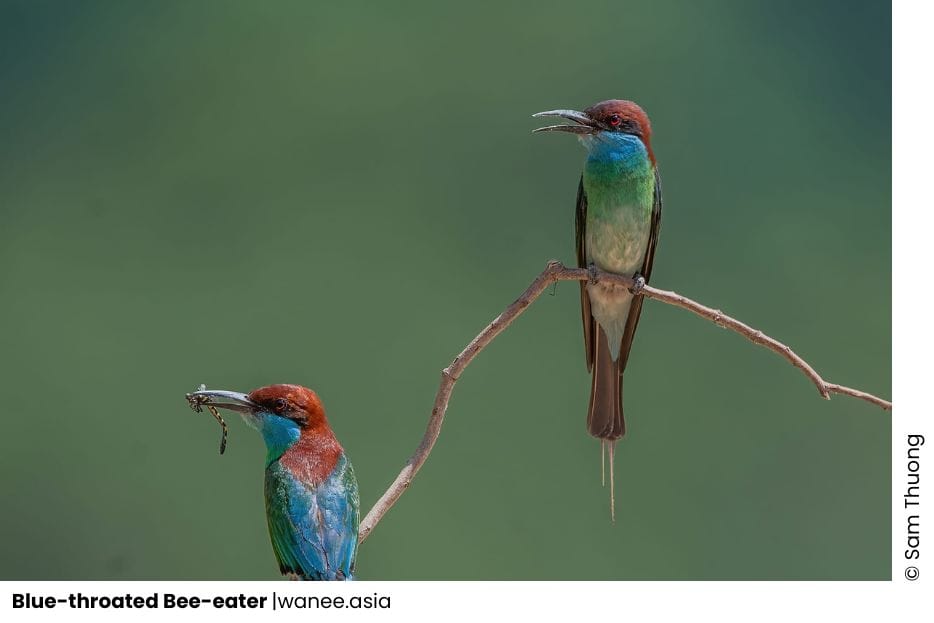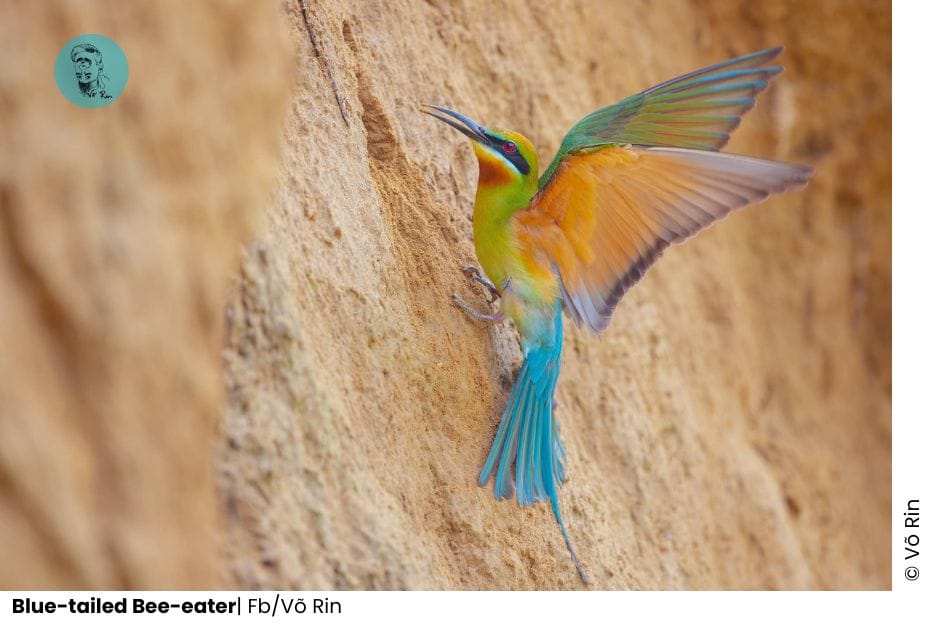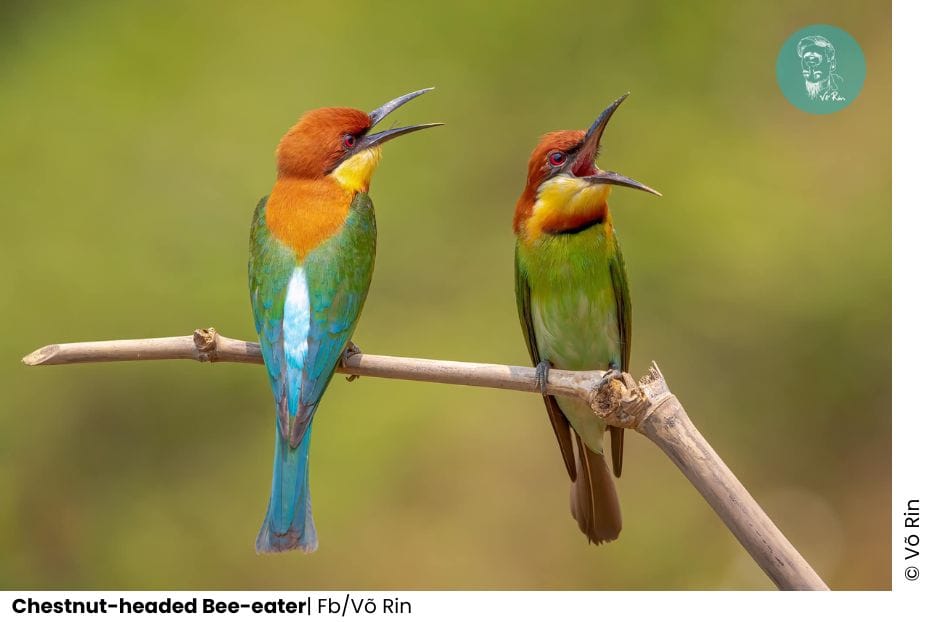Bee-eaters of Vietnam – Meropidae
With 5 species Bee-eaters of Vietnam, this is one of another family that has a number of species fewest in Vietnam. But it is not really hard to encounter them in Vietnam because most of all live even near people and nature. Mostly they have a small size except for Blue-beared Bee-eater. A Bee-eater has a Falcon size.
You may know Bee-eater really love to keep their feather clean. They spend more than 3 hours per day on this. It includes sunning, dust bathing, and water bathing.
The overview of Bee-eaters families
The Bee-eaters are a group of non-passerine birds in the family Meropidae, containing three genera and thirty species. Most species are found in Africa and Asia, with a few in southern Europe, Australia, and New Guinea. They are characterized by richly colored plumage, slender bodies, and usually elongated central tail feathers. All have long down-turned bills and medium to long wings, which may be pointed or round. Male and female plumages are usually similar.
As their name suggests, bee-eaters predominantly eat flying insects, especially bees and wasps, which are caught on the wing from an open perch. The insect’s stinger is removed by repeatedly hitting and rubbing the insect on a hard surface. During this process, pressure is applied to the insect’s body, thereby discharging most of the venom.
Most Bee-eaters are gregarious. They form colonies, nesting in burrows tunnelled into vertical sandy banks, often at the side of a river or in flat ground. As they mostly live in colonies, large numbers of nest holes may be seen together. The eggs are white, with typically five to the clutch. Most species are monogamous, and both parents care for their young, sometimes with assistance from related birds in the colony.
Bee-eaters may be killed by raptors; their nests are raided by rodents, weasels, martens and snakes, and they can carry various parasites. Some species are adversely affected by human activity or habitat loss, but none meet the International Union for Conservation of Nature’s vulnerability criteria, and all are therefore evaluated as “least concern”. Their conspicuous appearance means that they have been mentioned by ancient writers and incorporated into mythology.
Are you looking for Wildlife Tours in Vietnam?
WANEE VIETNAM is the right place for the "Wildlife Tours in Vietnam", we specialize in Birding, Wildlife watching, Herping, Photography-tours and general Edu-tours by our experts.
Bee-eaters of Vietnam species note

Blue-bearded Bee-eater Nyctyornis athertoni
Status: Fairly Common resident (throughout)
Best time to watch & Photo: All Year
Tour cover: Throughout
Hotspot: Dinh Mout, Cat Tien, Ma Da

Green Bee-eater Merops orientalis
Status: Fairly Common resident (throughout)
Best time to watch & Photo: All Year
Tours: Exclude Northern Vietnam
Hotspot: Cat Tien, Tan Phu, Go Cong

Blue-throated Bee-eater Merops viridis
Status: Uncommon resident in southern & Rare pass Migrant in North of Central
Best time to watch & Photo: Feb-Apr
Tours: South Vietnam
Hotspot: Cat Tien, Phong Nha – Ke Bang

Blue-tailed Bee-eater Merops philippinus
Status: Fairly Common resident (throughout)
Best time to watch & Photo: Feb-Apr
Tours: South & Coastline Central
Hotspot: Tram Chim, Can Gio, Cat Tien

Chestnut-headed Bee-eater Merops leschenaulti
Status: Local fairly common resident
Best time to watch & Photo: Feb-Apr
Tours: South of Central to Mekong Delta
Hotspot: Tram Chim, Cat Tien, Da Lat
Dalat Plateau Birding Herping and Wildlife Tours
The Dalat Plateau, rising 2,000 meters above sea level, is one of Vietnam’s most important [...]
Cat Tien National Park Birding Herping and Wildlife Tours
Cat Tien National Park tours offer an unforgettable experience with sightings of Germain’s Peacock Pheasant, [...]
Western Black Crested Gibbon – Nomascus concolor
Nestled within the verdant landscapes of Vietnam, the Western Black Crested Gibbon (Nomascus concolor) emerges [...]
Northern White-cheeked Gibbon – Nomascus leucogenys
The northern white-cheeked gibbon (Nomascus leucogenys) is a Critically Endangered gibbon species indigenous to South [...]
Northern Yellow-cheeked Crested Gibbon – Nomascus annamensis
The Northern Yellow-Cheeked Crested Gibbon, or Nomascus annamensis, is an exclusive primate species found in [...]
Eastern Black Crested Gibbon – “Cao-vit Gibbon” – Nomascus nasutus
Nestled within the dense, emerald-green forests of Vietnam, the Eastern Black Crested Gibbon (Nomascus nasutus), [...]